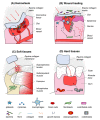An Overview of the Use of Equine Collagen as Emerging Material for Biomedical Applications
- PMID: 33139660
- PMCID: PMC7712325
- DOI: 10.3390/jfb11040079
An Overview of the Use of Equine Collagen as Emerging Material for Biomedical Applications
Abstract
Type I collagen has always aroused great interest in the field of life-science and bioengineering, thanks to its favorable structural properties and bioactivity. For this reason, in the last five decades it has been widely studied and employed as biomaterial for the manufacture of implantable medical devices. Commonly used sources of collagen are represented by bovine and swine but their applications are limited because of the zoonosis transmission risks, the immune response and the religious constrains. Thus, type-I collagen isolated from horse tendon has recently gained increasing interest as an attractive alternative, so that, although bovine and porcine derived collagens still remain the most common ones, more and more companies started to bring to market a various range of equine collagen-based products. In this context, this work aims to overview the properties of equine collagen making it particularly appealing in medicine, cosmetics and pharmaceuticals, as well as its main biomedical applications and the currently approved equine collagen-based medical devices, focusing on experimental studies and clinical trials of the last 15 years. To the best of our knowledge, this is the first review focusing on the use of equine collagen, as well as on equine collagen-based marketed products for healthcare.
Keywords: biomaterials; equine; medical devices; type I collagen.
Conflict of interest statement
The authors declare no conflict of interest.
Figures



References
-
- Sharma S., Dwivedi S., Chandra S., Srivastava A., Vijay P. Collagen: A brief analysis. J. Oral Maxillofac. Pathol. 2019;10:11–17. doi: 10.5005/jp-journals-10037-1143. - DOI
-
- Nimni M.E., Harkness R.D. Molecular structures and functions of collagen. In: Nimni M.E., editor. Collagen. CRC Press; Boca Raton, FL, USA: 1998. pp. 1–78.
Publication types
LinkOut - more resources
Full Text Sources

